JEEP WRANGLER 2023 Owners Manual
Manufacturer: JEEP, Model Year: 2023, Model line: WRANGLER, Model: JEEP WRANGLER 2023Pages: 396, PDF Size: 25.15 MB
Page 361 of 396
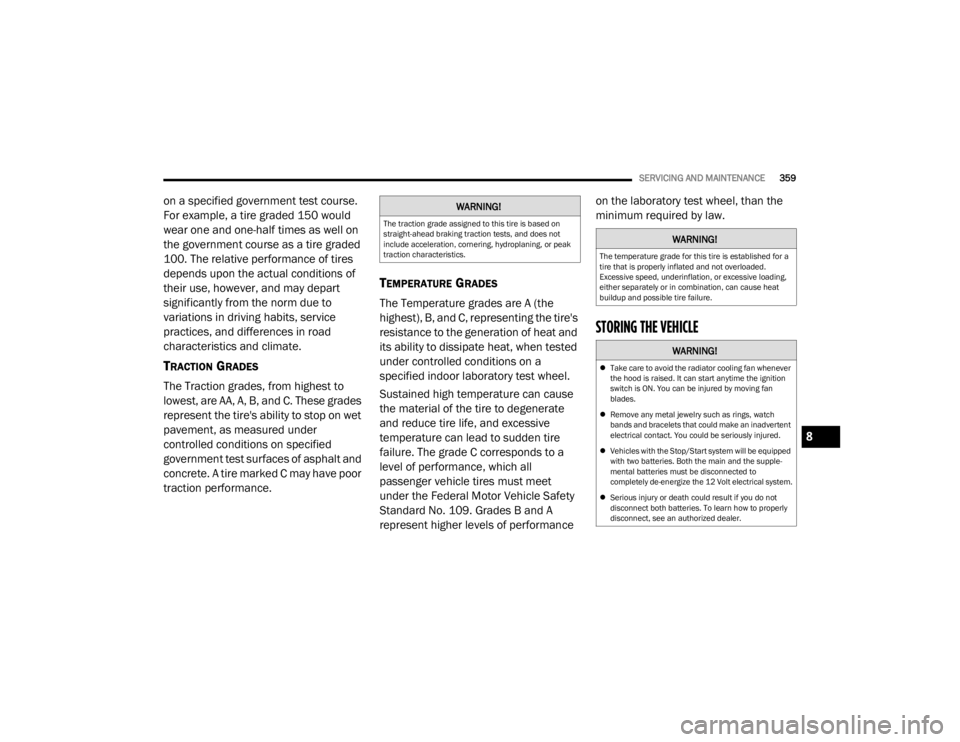
SERVICING AND MAINTENANCE359
on a specified government test course.
For example, a tire graded 150 would
wear one and one-half times as well on
the government course as a tire graded
100. The relative performance of tires
depends upon the actual conditions of
their use, however, and may depart
significantly from the norm due to
variations in driving habits, service
practices, and differences in road
characteristics and climate.
TRACTION GRADES
The Traction grades, from highest to
lowest, are AA, A, B, and C. These grades
represent the tire's ability to stop on wet
pavement, as measured under
controlled conditions on specified
government test surfaces of asphalt and
concrete. A tire marked C may have poor
traction performance.
TEMPERATURE GRADES
The Temperature grades are A (the
highest), B, and C, representing the tire's
resistance to the generation of heat and
its ability to dissipate heat, when tested
under controlled conditions on a
specified indoor laboratory test wheel.
Sustained high temperature can cause
the material of the tire to degenerate
and reduce tire life, and excessive
temperature can lead to sudden tire
failure. The grade C corresponds to a
level of performance, which all
passenger vehicle tires must meet
under the Federal Motor Vehicle Safety
Standard No. 109. Grades B and A
represent higher levels of performance on the laboratory test wheel, than the
minimum required by law.
STORING THE VEHICLE
WARNING!
The traction grade assigned to this tire is based on
straight-ahead braking traction tests, and does not
include acceleration, cornering, hydroplaning, or peak
traction characteristics.
WARNING!
The temperature grade for this tire is established for a
tire that is properly inflated and not overloaded.
Excessive speed, underinflation, or excessive loading,
either separately or in combination, can cause heat
buildup and possible tire failure.
WARNING!
Take care to avoid the radiator cooling fan whenever
the hood is raised. It can start anytime the ignition
switch is ON. You can be injured by moving fan
blades.
Remove any metal jewelry such as rings, watch
bands and bracelets that could make an inadvertent
electrical contact. You could be seriously injured.
Vehicles with the Stop/Start system will be equipped
with two batteries. Both the main and the supple -
mental batteries must be disconnected to
completely de-energize the 12 Volt electrical system.
Serious injury or death could result if you do not
disconnect both batteries. To learn how to properly
disconnect, see an authorized dealer.
8
23_JL_OM_EN_USC_t.book Page 359
Page 362 of 396
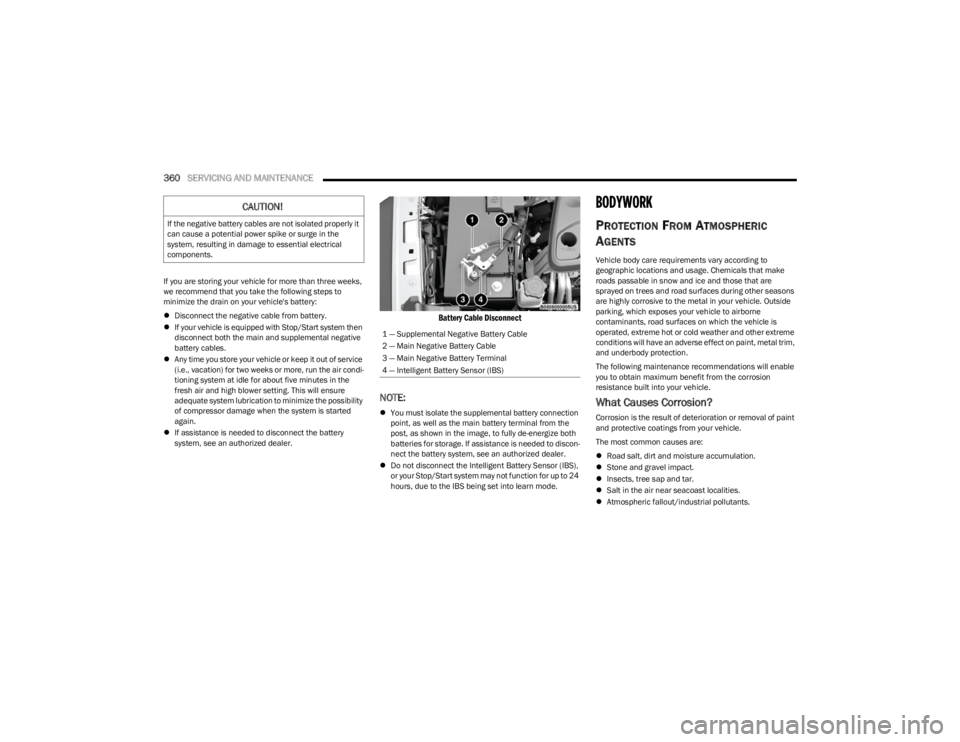
360SERVICING AND MAINTENANCE
If you are storing your vehicle for more than three weeks,
we recommend that you take the following steps to
minimize the drain on your vehicle's battery:
Disconnect the negative cable from battery.
If your vehicle is equipped with Stop/Start system then
disconnect both the main and supplemental negative
battery cables.
Any time you store your vehicle or keep it out of service
(i.e., vacation) for two weeks or more, run the air condi -
tioning system at idle for about five minutes in the
fresh air and high blower setting. This will ensure
adequate system lubrication to minimize the possibility
of compressor damage when the system is started
again.
If assistance is needed to disconnect the battery
system, see an authorized dealer.
Battery Cable Disconnect
NOTE:
You must isolate the supplemental battery connection
point, as well as the main battery terminal from the
post, as shown in the image, to fully de-energize both
batteries for storage. If assistance is needed to discon -
nect the battery system, see an authorized dealer.
Do not disconnect the Intelligent Battery Sensor (IBS),
or your Stop/Start system may not function for up to 24
hours, due to the IBS being set into learn mode.
BODYWORK
PROTECTION FROM ATMOSPHERIC
A
GENTS
Vehicle body care requirements vary according to
geographic locations and usage. Chemicals that make
roads passable in snow and ice and those that are
sprayed on trees and road surfaces during other seasons
are highly corrosive to the metal in your vehicle. Outside
parking, which exposes your vehicle to airborne
contaminants, road surfaces on which the vehicle is
operated, extreme hot or cold weather and other extreme
conditions will have an adverse effect on paint, metal trim,
and underbody protection.
The following maintenance recommendations will enable
you to obtain maximum benefit from the corrosion
resistance built into your vehicle.
What Causes Corrosion?
Corrosion is the result of deterioration or removal of paint
and protective coatings from your vehicle.
The most common causes are:
Road salt, dirt and moisture accumulation.
Stone and gravel impact.
Insects, tree sap and tar.
Salt in the air near seacoast localities.
Atmospheric fallout/industrial pollutants.
CAUTION!
If the negative battery cables are not isolated properly it
can cause a potential power spike or surge in the
system, resulting in damage to essential electrical
components.
1 — Supplemental Negative Battery Cable
2 — Main Negative Battery Cable
3 — Main Negative Battery Terminal
4 — Intelligent Battery Sensor (IBS)
23_JL_OM_EN_USC_t.book Page 360
Page 363 of 396
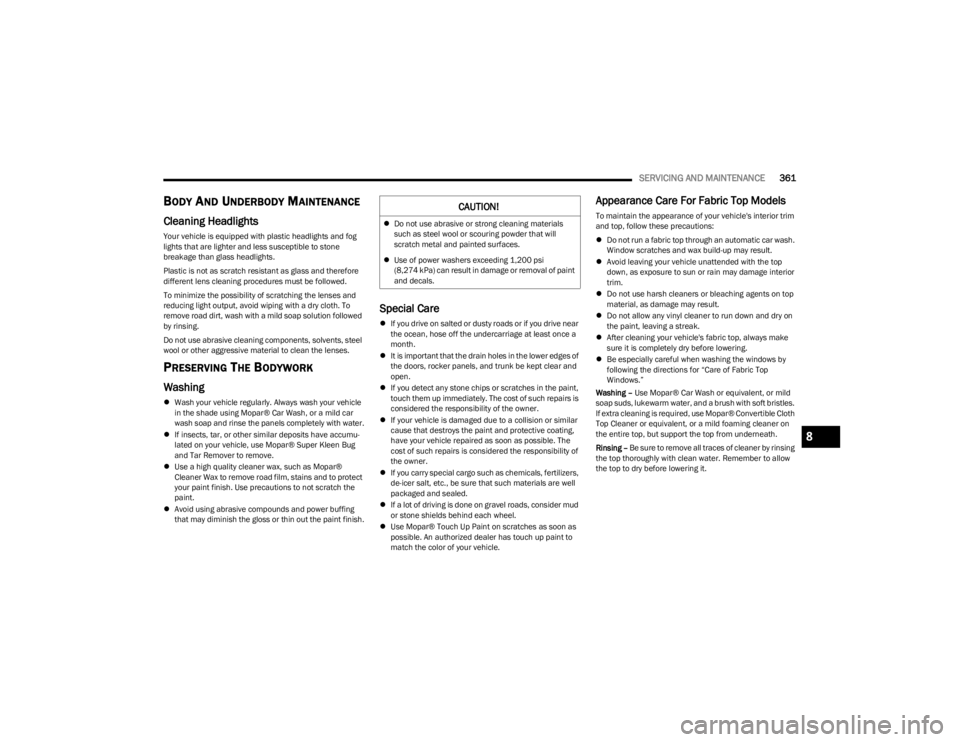
SERVICING AND MAINTENANCE361
8
BODY AND UNDERBODY MAINTENANCE
Cleaning Headlights
Your vehicle is equipped with plastic headlights and fog
lights that are lighter and less susceptible to stone
breakage than glass headlights.
Plastic is not as scratch resistant as glass and therefore
different lens cleaning procedures must be followed.
To minimize the possibility of scratching the lenses and
reducing light output, avoid wiping with a dry cloth. To
remove road dirt, wash with a mild soap solution followed
by rinsing.
Do not use abrasive cleaning components, solvents, steel
wool or other aggressive material to clean the lenses.
PRESERVING THE BODYWORK
Washing
Wash your vehicle regularly. Always wash your vehicle
in the shade using Mopar® Car Wash, or a mild car
wash soap and rinse the panels completely with water.
If insects, tar, or other similar deposits have accumu -
lated on your vehicle, use Mopar® Super Kleen Bug
and Tar Remover to remove.
Use a high quality cleaner wax, such as Mopar®
Cleaner Wax to remove road film, stains and to protect
your paint finish. Use precautions to not scratch the
paint.
Avoid using abrasive compounds and power buffing
that may diminish the gloss or thin out the paint finish.
Special Care
If you drive on salted or dusty roads or if you drive near
the ocean, hose off the undercarriage at least once a
month.
It is important that the drain holes in the lower edges of
the doors, rocker panels, and trunk be kept clear and
open.
If you detect any stone chips or scratches in the paint,
touch them up immediately. The cost of such repairs is
considered the responsibility of the owner.
If your vehicle is damaged due to a collision or similar
cause that destroys the paint and protective coating,
have your vehicle repaired as soon as possible. The
cost of such repairs is considered the responsibility of
the owner.
If you carry special cargo such as chemicals, fertilizers,
de-icer salt, etc., be sure that such materials are well
packaged and sealed.
If a lot of driving is done on gravel roads, consider mud
or stone shields behind each wheel.
Use Mopar® Touch Up Paint on scratches as soon as
possible. An authorized dealer has touch up paint to
match the color of your vehicle.
Appearance Care For Fabric Top Models
To maintain the appearance of your vehicle's interior trim
and top, follow these precautions:
Do not run a fabric top through an automatic car wash.
Window scratches and wax build-up may result.
Avoid leaving your vehicle unattended with the top
down, as exposure to sun or rain may damage interior
trim.
Do not use harsh cleaners or bleaching agents on top
material, as damage may result.
Do not allow any vinyl cleaner to run down and dry on
the paint, leaving a streak.
After cleaning your vehicle's fabric top, always make
sure it is completely dry before lowering.
Be especially careful when washing the windows by
following the directions for “Care of Fabric Top
Windows.”
Washing – Use Mopar® Car Wash or equivalent, or mild
soap suds, lukewarm water, and a brush with soft bristles.
If extra cleaning is required, use Mopar® Convertible Cloth
Top Cleaner or equivalent, or a mild foaming cleaner on
the entire top, but support the top from underneath.
Rinsing – Be sure to remove all traces of cleaner by rinsing
the top thoroughly with clean water. Remember to allow
the top to dry before lowering it.CAUTION!
Do not use abrasive or strong cleaning materials
such as steel wool or scouring powder that will
scratch metal and painted surfaces.
Use of power washers exceeding 1,200 psi
(8,274 kPa) can result in damage or removal of paint
and decals.
23_JL_OM_EN_USC_t.book Page 361
Page 364 of 396
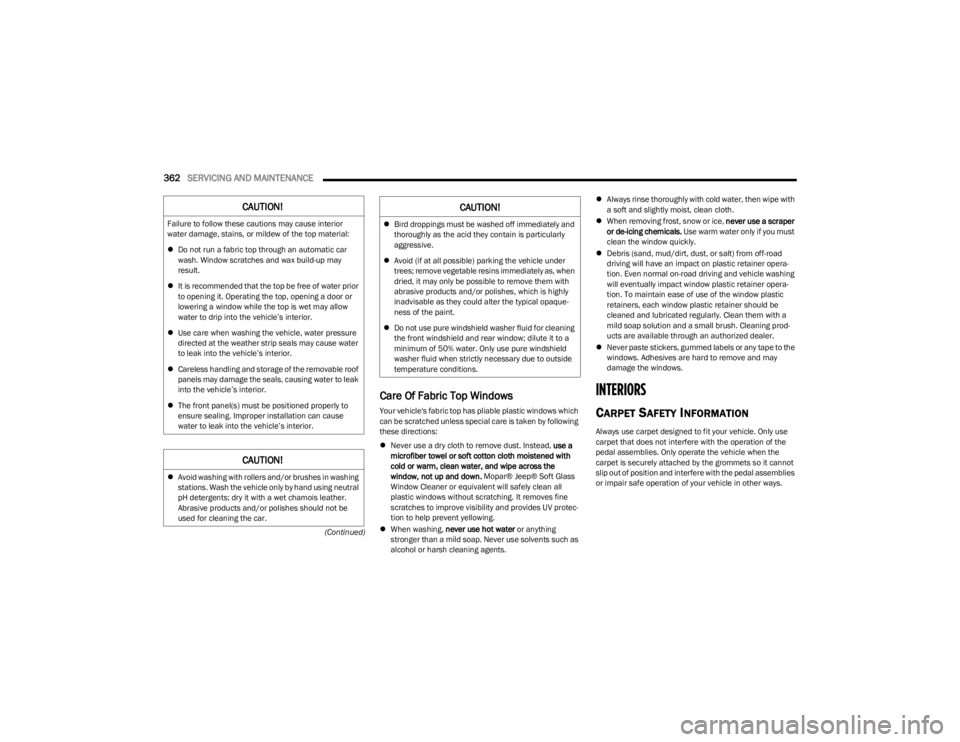
362SERVICING AND MAINTENANCE
(Continued)
Care Of Fabric Top Windows
Your vehicle's fabric top has pliable plastic windows which
can be scratched unless special care is taken by following
these directions:
Never use a dry cloth to remove dust. Instead, use a
microfiber towel or soft cotton cloth moistened with
cold or warm, clean water, and wipe across the
window, not up and down. Mopar® Jeep® Soft Glass
Window Cleaner or equivalent will safely clean all
plastic windows without scratching. It removes fine
scratches to improve visibility and provides UV protec -
tion to help prevent yellowing.
When washing, never use hot water or anything
stronger than a mild soap. Never use solvents such as
alcohol or harsh cleaning agents.
Always rinse thoroughly with cold water, then wipe with
a soft and slightly moist, clean cloth.
When removing frost, snow or ice, never use a scraper
or de-icing chemicals. Use warm water only if you must
clean the window quickly.
Debris (sand, mud/dirt, dust, or salt) from off-road
driving will have an impact on plastic retainer opera -
tion. Even normal on-road driving and vehicle washing
will eventually impact window plastic retainer opera -
tion. To maintain ease of use of the window plastic
retainers, each window plastic retainer should be
cleaned and lubricated regularly. Clean them with a
mild soap solution and a small brush. Cleaning prod -
ucts are available through an authorized dealer.
Never paste stickers, gummed labels or any tape to the
windows. Adhesives are hard to remove and may
damage the windows.
INTERIORS
CARPET SAFETY INFORMATION
Always use carpet designed to fit your vehicle. Only use
carpet that does not interfere with the operation of the
pedal assemblies. Only operate the vehicle when the
carpet is securely attached by the grommets so it cannot
slip out of position and interfere with the pedal assemblies
or impair safe operation of your vehicle in other ways.
CAUTION!
Failure to follow these cautions may cause interior
water damage, stains, or mildew of the top material:
Do not run a fabric top through an automatic car
wash. Window scratches and wax build-up may
result.
It is recommended that the top be free of water prior
to opening it. Operating the top, opening a door or
lowering a window while the top is wet may allow
water to drip into the vehicle’s interior.
Use care when washing the vehicle, water pressure
directed at the weather strip seals may cause water
to leak into the vehicle’s interior.
Careless handling and storage of the removable roof
panels may damage the seals, causing water to leak
into the vehicle’s interior.
The front panel(s) must be positioned properly to
ensure sealing. Improper installation can cause
water to leak into the vehicle’s interior.
CAUTION!
Avoid washing with rollers and/or brushes in washing
stations. Wash the vehicle only by hand using neutral
pH detergents; dry it with a wet chamois leather.
Abrasive products and/or polishes should not be
used for cleaning the car.
Bird droppings must be washed off immediately and
thoroughly as the acid they contain is particularly
aggressive.
Avoid (if at all possible) parking the vehicle under
trees; remove vegetable resins immediately as, when
dried, it may only be possible to remove them with
abrasive products and/or polishes, which is highly
inadvisable as they could alter the typical opaque -
ness of the paint.
Do not use pure windshield washer fluid for cleaning
the front windshield and rear window; dilute it to a
minimum of 50% water. Only use pure windshield
washer fluid when strictly necessary due to outside
temperature conditions.
CAUTION!
23_JL_OM_EN_USC_t.book Page 362
Page 365 of 396
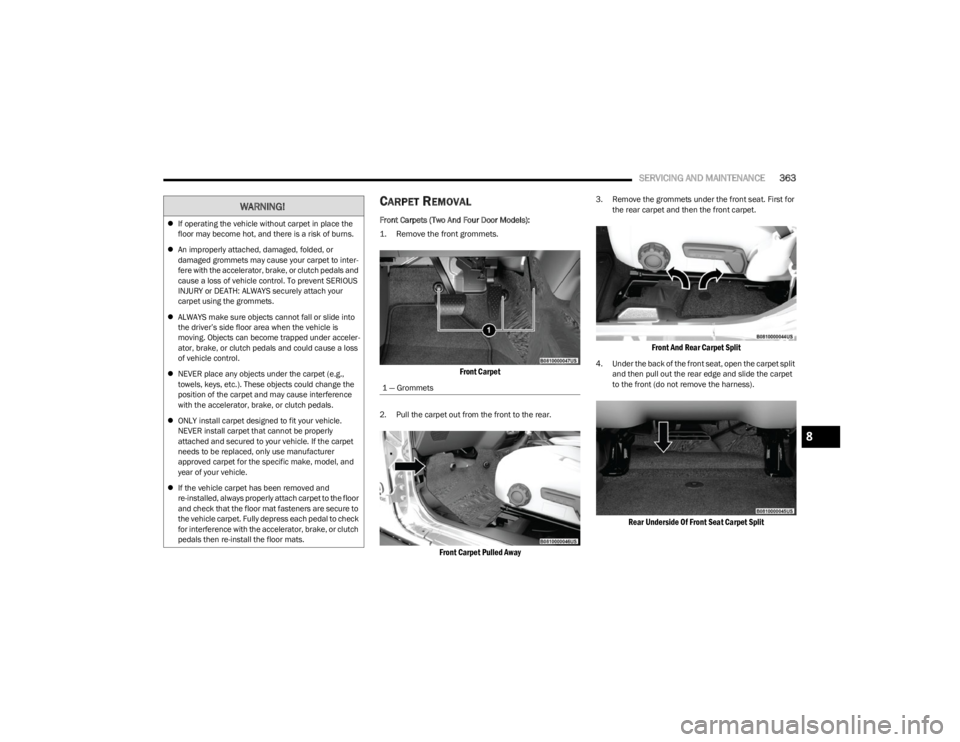
SERVICING AND MAINTENANCE363
CARPET REMOVAL
Front Carpets (Two And Four Door Models):
1. Remove the front grommets.
Front Carpet
2. Pull the carpet out from the front to the rear.
Front Carpet Pulled Away
3. Remove the grommets under the front seat. First for
the rear carpet and then the front carpet.
Front And Rear Carpet Split
4. Under the back of the front seat, open the carpet split and then pull out the rear edge and slide the carpet
to the front (do not remove the harness).
Rear Underside Of Front Seat Carpet Split
WARNING!
If operating the vehicle without carpet in place the
floor may become hot, and there is a risk of burns.
An improperly attached, damaged, folded, or
damaged grommets may cause your carpet to inter -
fere with the accelerator, brake, or clutch pedals and
cause a loss of vehicle control. To prevent SERIOUS
INJURY or DEATH: ALWAYS securely attach your
carpet using the grommets.
ALWAYS make sure objects cannot fall or slide into
the driver’s side floor area when the vehicle is
moving. Objects can become trapped under acceler -
ator, brake, or clutch pedals and could cause a loss
of vehicle control.
NEVER place any objects under the carpet (e.g.,
towels, keys, etc.). These objects could change the
position of the carpet and may cause interference
with the accelerator, brake, or clutch pedals.
ONLY install carpet designed to fit your vehicle.
NEVER install carpet that cannot be properly
attached and secured to your vehicle. If the carpet
needs to be replaced, only use manufacturer
approved carpet for the specific make, model, and
year of your vehicle.
If the vehicle carpet has been removed and
re-installed, always properly attach carpet to the floor
and check that the floor mat fasteners are secure to
the vehicle carpet. Fully depress each pedal to check
for interference with the accelerator, brake, or clutch
pedals then re-install the floor mats.
1 — Grommets
8
23_JL_OM_EN_USC_t.book Page 363
Page 366 of 396
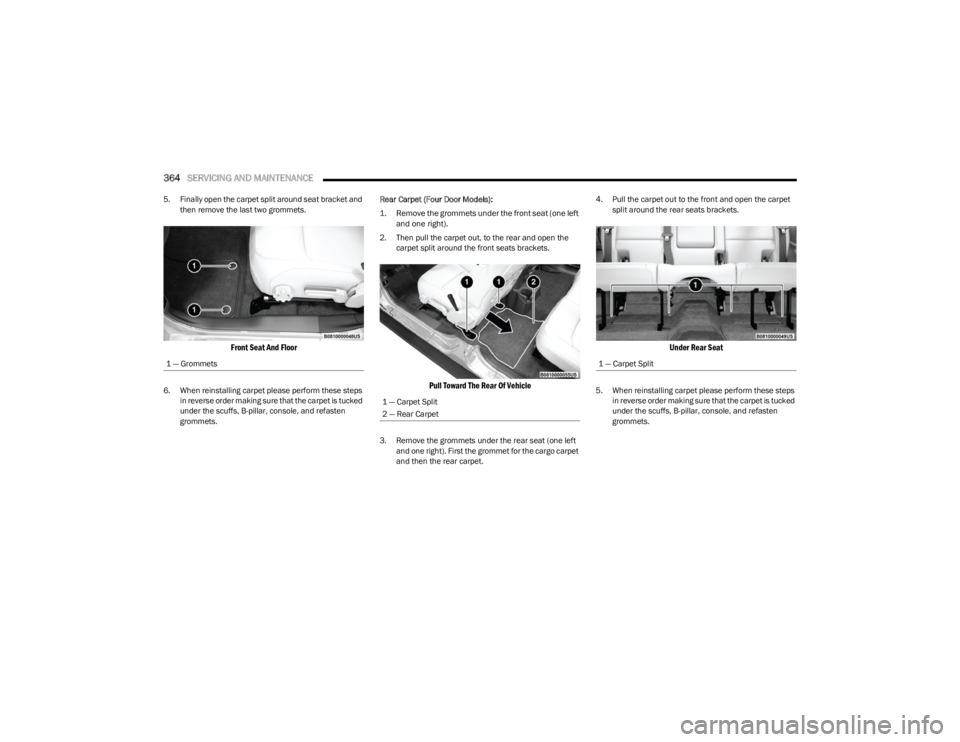
364SERVICING AND MAINTENANCE
5. Finally open the carpet split around seat bracket and
then remove the last two grommets.
Front Seat And Floor
6. When reinstalling carpet please perform these steps in reverse order making sure that the carpet is tucked
under the scuffs, B-pillar, console, and refasten
grommets. Rear Carpet (Four Door Models):
1. Remove the grommets under the front seat (one left
and one right).
2. Then pull the carpet out, to the rear and open the carpet split around the front seats brackets.
Pull Toward The Rear Of Vehicle
3. Remove the grommets under the rear seat (one left and one right). First the grommet for the cargo carpet
and then the rear carpet. 4. Pull the carpet out to the front and open the carpet
split around the rear seats brackets.
Under Rear Seat
5. When reinstalling carpet please perform these steps in reverse order making sure that the carpet is tucked
under the scuffs, B-pillar, console, and refasten
grommets.
1 — Grommets1 — Carpet Split
2 — Rear Carpet
1 — Carpet Split
23_JL_OM_EN_USC_t.book Page 364
Page 367 of 396
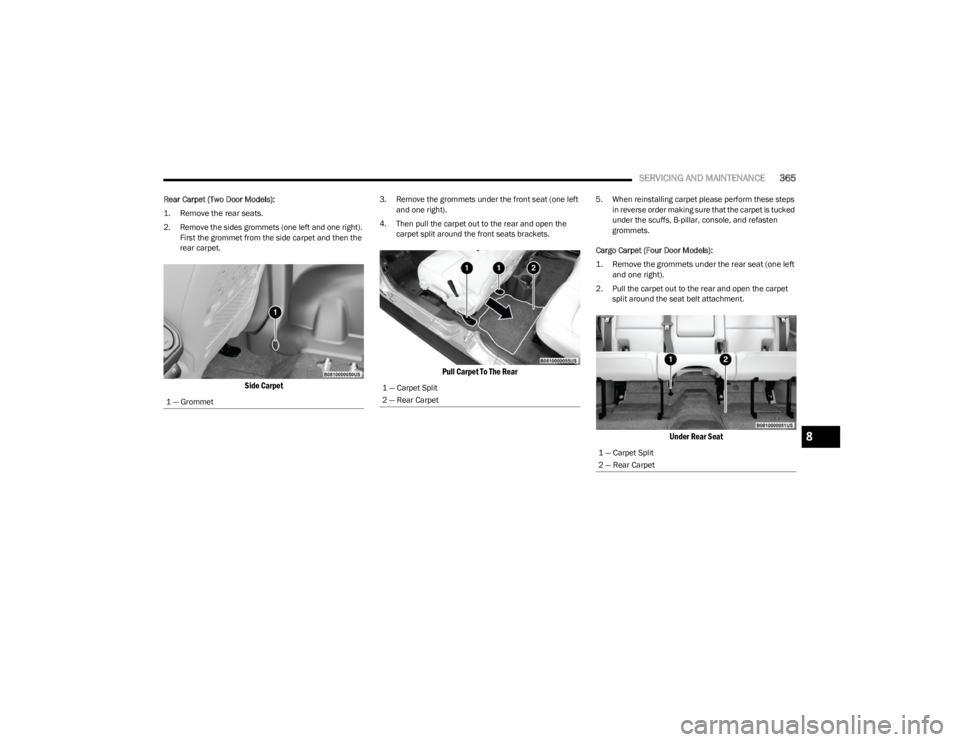
SERVICING AND MAINTENANCE365
Rear Carpet (Two Door Models):
1. Remove the rear seats.
2. Remove the sides grommets (one left and one right).
First the grommet from the side carpet and then the
rear carpet.
Side Carpet
3. Remove the grommets under the front seat (one left and one right).
4. Then pull the carpet out to the rear and open the carpet split around the front seats brackets.
Pull Carpet To The Rear
5. When reinstalling carpet please perform these steps in reverse order making sure that the carpet is tucked
under the scuffs, B-pillar, console, and refasten
grommets.
Cargo Carpet (Four Door Models):
1. Remove the grommets under the rear seat (one left and one right).
2. Pull the carpet out to the rear and open the carpet split around the seat belt attachment.
Under Rear Seat
1 — Grommet
1 — Carpet Split
2 — Rear Carpet
1 — Carpet Split
2 — Rear Carpet
8
23_JL_OM_EN_USC_t.book Page 365
Page 368 of 396
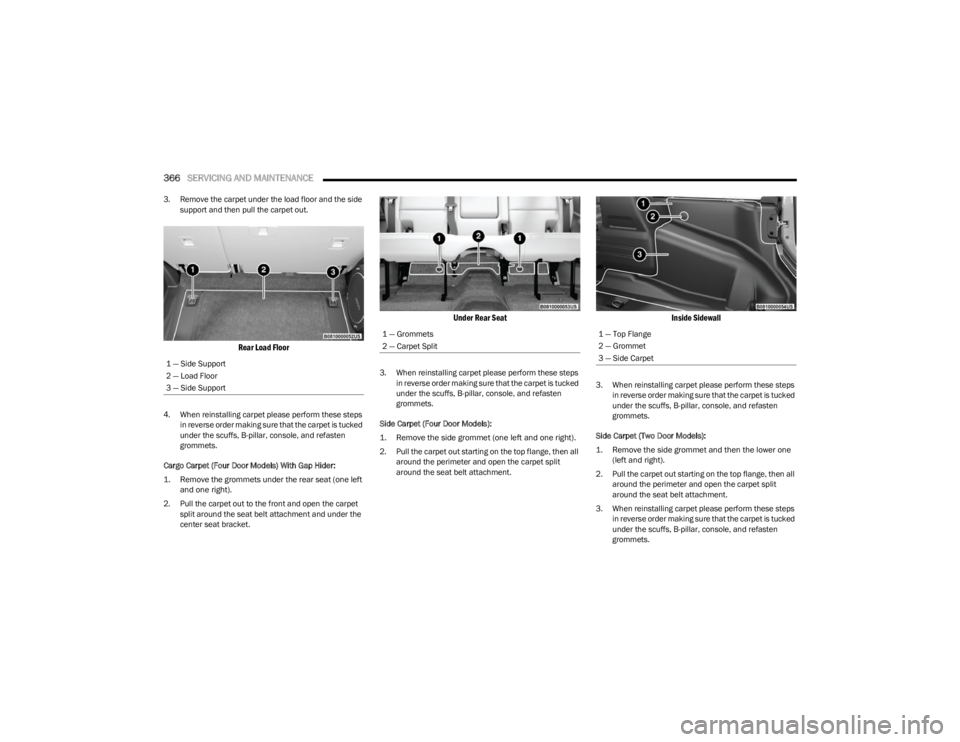
366SERVICING AND MAINTENANCE
3. Remove the carpet under the load floor and the side
support and then pull the carpet out.
Rear Load Floor
4. When reinstalling carpet please perform these steps in reverse order making sure that the carpet is tucked
under the scuffs, B-pillar, console, and refasten
grommets.
Cargo Carpet (Four Door Models) With Gap Hider:
1. Remove the grommets under the rear seat (one left and one right).
2. Pull the carpet out to the front and open the carpet split around the seat belt attachment and under the
center seat bracket.
Under Rear Seat
3. When reinstalling carpet please perform these steps in reverse order making sure that the carpet is tucked
under the scuffs, B-pillar, console, and refasten
grommets.
Side Carpet (Four Door Models):
1. Remove the side grommet (one left and one right).
2. Pull the carpet out starting on the top flange, then all around the perimeter and open the carpet split
around the seat belt attachment.
Inside Sidewall
3. When reinstalling carpet please perform these steps in reverse order making sure that the carpet is tucked
under the scuffs, B-pillar, console, and refasten
grommets.
Side Carpet (Two Door Models):
1. Remove the side grommet and then the lower one (left and right).
2. Pull the carpet out starting on the top flange, then all around the perimeter and open the carpet split
around the seat belt attachment.
3. When reinstalling carpet please perform these steps in reverse order making sure that the carpet is tucked
under the scuffs, B-pillar, console, and refasten
grommets.
1 — Side Support
2 — Load Floor
3 — Side Support
1 — Grommets
2 — Carpet Split1 — Top Flange
2 — Grommet
3 — Side Carpet
23_JL_OM_EN_USC_t.book Page 366
Page 369 of 396
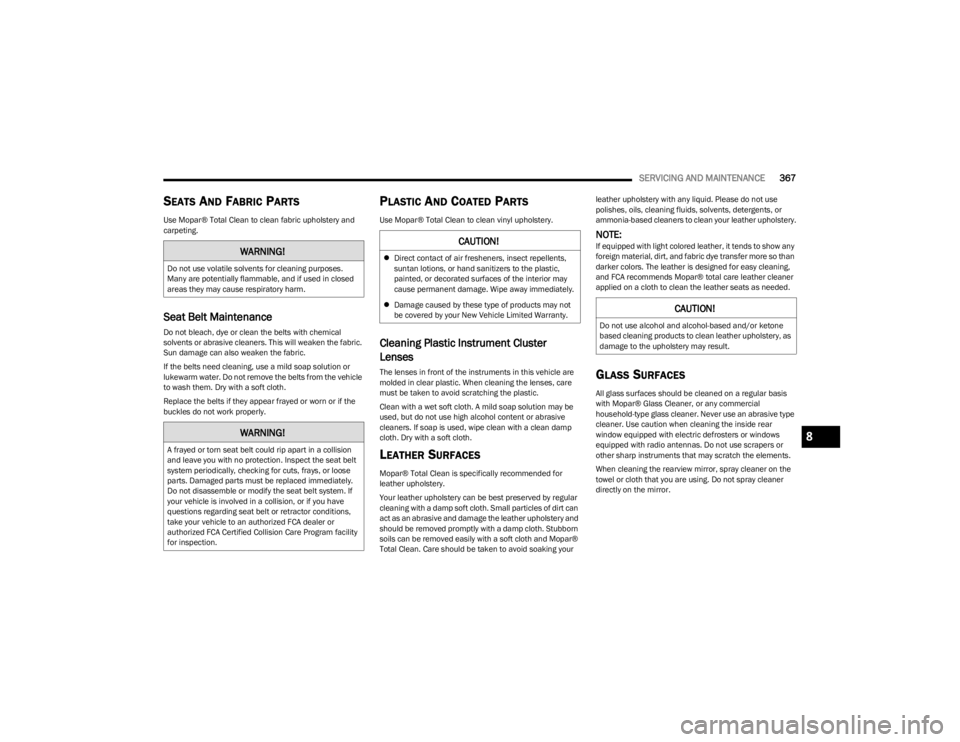
SERVICING AND MAINTENANCE367
SEATS AND FABRIC PARTS
Use Mopar® Total Clean to clean fabric upholstery and
carpeting.
Seat Belt Maintenance
Do not bleach, dye or clean the belts with chemical
solvents or abrasive cleaners. This will weaken the fabric.
Sun damage can also weaken the fabric.
If the belts need cleaning, use a mild soap solution or
lukewarm water. Do not remove the belts from the vehicle
to wash them. Dry with a soft cloth.
Replace the belts if they appear frayed or worn or if the
buckles do not work properly.
PLASTIC AND COATED PARTS
Use Mopar® Total Clean to clean vinyl upholstery.
Cleaning Plastic Instrument Cluster
Lenses
The lenses in front of the instruments in this vehicle are
molded in clear plastic. When cleaning the lenses, care
must be taken to avoid scratching the plastic.
Clean with a wet soft cloth. A mild soap solution may be
used, but do not use high alcohol content or abrasive
cleaners. If soap is used, wipe clean with a clean damp
cloth. Dry with a soft cloth.
LEATHER SURFACES
Mopar® Total Clean is specifically recommended for
leather upholstery.
Your leather upholstery can be best preserved by regular
cleaning with a damp soft cloth. Small particles of dirt can
act as an abrasive and damage the leather upholstery and
should be removed promptly with a damp cloth. Stubborn
soils can be removed easily with a soft cloth and Mopar®
Total Clean. Care should be taken to avoid soaking your leather upholstery with any liquid. Please do not use
polishes, oils, cleaning fluids, solvents, detergents, or
ammonia-based cleaners to clean your leather upholstery.
NOTE:If equipped with light colored leather, it tends to show any
foreign material, dirt, and fabric dye transfer more so than
darker colors. The leather is designed for easy cleaning,
and FCA recommends Mopar® total care leather cleaner
applied on a cloth to clean the leather seats as needed.
GLASS SURFACES
All glass surfaces should be cleaned on a regular basis
with Mopar® Glass Cleaner, or any commercial
household-type glass cleaner. Never use an abrasive type
cleaner. Use caution when cleaning the inside rear
window equipped with electric defrosters or windows
equipped with radio antennas. Do not use scrapers or
other sharp instruments that may scratch the elements.
When cleaning the rearview mirror, spray cleaner on the
towel or cloth that you are using. Do not spray cleaner
directly on the mirror.
WARNING!
Do not use volatile solvents for cleaning purposes.
Many are potentially flammable, and if used in closed
areas they may cause respiratory harm.
WARNING!
A frayed or torn seat belt could rip apart in a collision
and leave you with no protection. Inspect the seat belt
system periodically, checking for cuts, frays, or loose
parts. Damaged parts must be replaced immediately.
Do not disassemble or modify the seat belt system. If
your vehicle is involved in a collision, or if you have
questions regarding seat belt or retractor conditions,
take your vehicle to an authorized FCA dealer or
authorized FCA Certified Collision Care Program facility
for inspection.
CAUTION!
Direct contact of air fresheners, insect repellents,
suntan lotions, or hand sanitizers to the plastic,
painted, or decorated surfaces of the interior may
cause permanent damage. Wipe away immediately.
Damage caused by these type of products may not
be covered by your New Vehicle Limited Warranty.
CAUTION!
Do not use alcohol and alcohol-based and/or ketone
based cleaning products to clean leather upholstery, as
damage to the upholstery may result.
8
23_JL_OM_EN_USC_t.book Page 367
Page 370 of 396
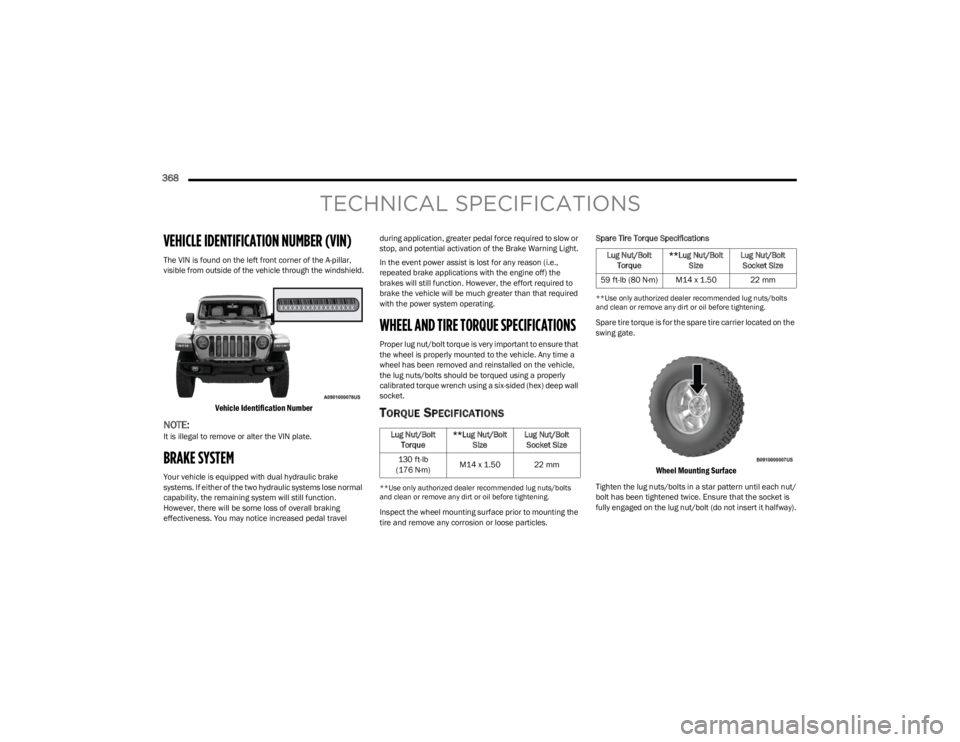
368
TECHNICAL SPECIFICATIONS
VEHICLE IDENTIFICATION NUMBER (VIN)
The VIN is found on the left front corner of the A-pillar,
visible from outside of the vehicle through the windshield.
Vehicle Identification Number
NOTE:It is illegal to remove or alter the VIN plate.
BRAKE SYSTEM
Your vehicle is equipped with dual hydraulic brake
systems. If either of the two hydraulic systems lose normal
capability, the remaining system will still function.
However, there will be some loss of overall braking
effectiveness. You may notice increased pedal travel during application, greater pedal force required to slow or
stop, and potential activation of the Brake Warning Light.
In the event power assist is lost for any reason (i.e.,
repeated brake applications with the engine off) the
brakes will still function. However, the effort required to
brake the vehicle will be much greater than that required
with the power system operating.
WHEEL AND TIRE TORQUE SPECIFICATIONS
Proper lug nut/bolt torque is very important to ensure that
the wheel is properly mounted to the vehicle. Any time a
wheel has been removed and reinstalled on the vehicle,
the lug nuts/bolts should be torqued using a properly
calibrated torque wrench using a six-sided (hex) deep wall
socket.
TORQUE SPECIFICATIONS
**Use only authorized dealer recommended lug nuts/bolts
and clean or remove any dirt or oil before tightening.
Inspect the wheel mounting surface prior to mounting the
tire and remove any corrosion or loose particles.Spare Tire Torque Specifications
**Use only authorized dealer recommended lug nuts/bolts
and clean or remove any dirt or oil before tightening.
Spare tire torque is for the spare tire carrier located on the
swing gate.
Wheel Mounting Surface
Tighten the lug nuts/bolts in a star pattern until each nut/
bolt has been tightened twice. Ensure that the socket is
fully engaged on the lug nut/bolt (do not insert it halfway).
Lug Nut/Bolt
Torque **Lug Nut/Bolt
Size Lug Nut/Bolt
Socket Size
130 ft-lb
(176 N·m) M14 x 1.50 22 mm
Lug Nut/Bolt
Torque **Lug Nut/Bolt
Size Lug Nut/Bolt
Socket Size
59 ft-lb (80 N·m) M14 x 1.50 22 mm
23_JL_OM_EN_USC_t.book Page 368